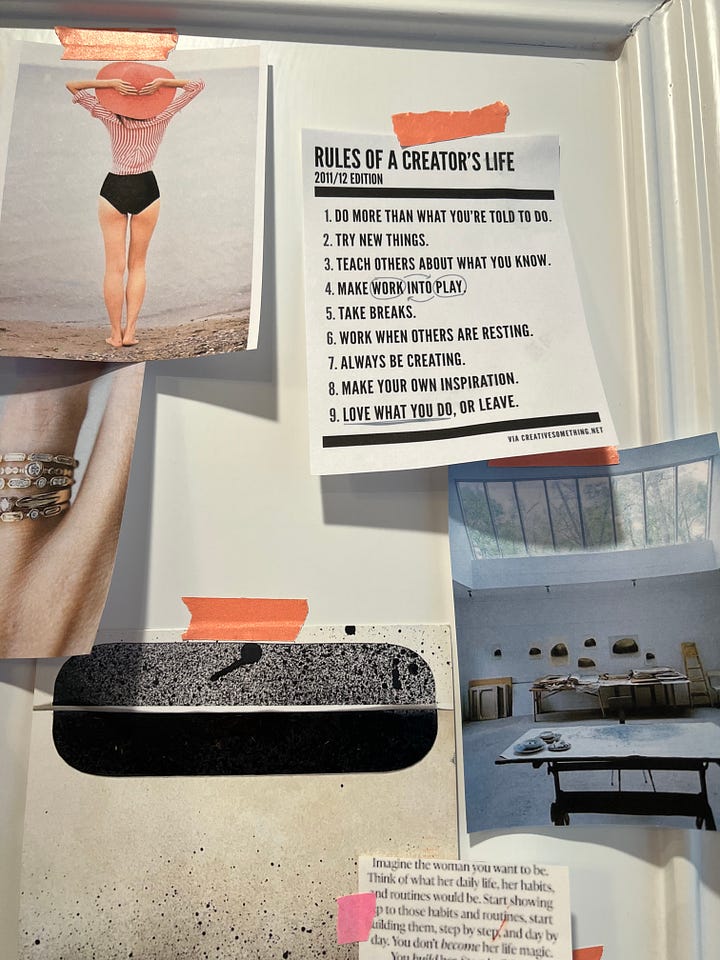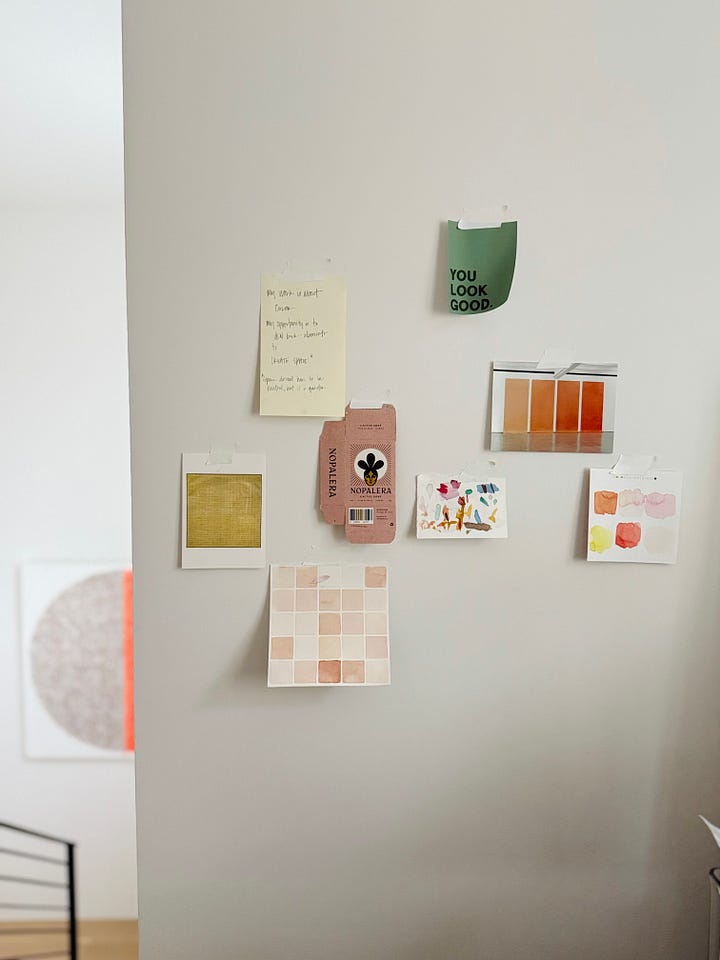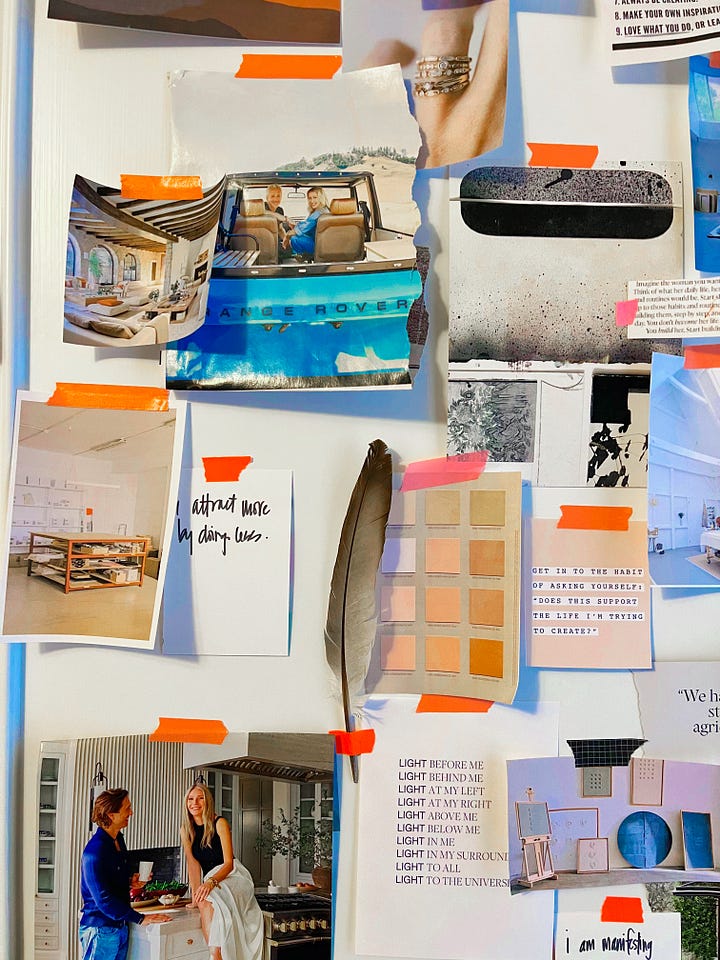Story time. Prior to becoming a self-employed artist, wallpaper designer, and consultant, I worked for 20 years at the same global fashion company. Starting as a marketing intern and pivoting my way through many, many jobs, assignments and departments, I ultimately ended up on a team that was responsible for setting the concept for product, visual and image design teams.
To do this, we were constantly scouring the world (and the internet) for inspiration. Obsessively reading, scouting, shopping, collecting everything we found that could spark the next big idea for our design teams. Museum exhibits from Agnes Martin, Paul Klee or Henri Matisse inspired line work and color usage. Vintage Life and Time magazines informed graphics, aged color palettes and brand design. Furniture fairs and car shows inspired material selection and product shape. This role is where I truly developed my love language around color and texture, which to this day informs everything I create in the studio.
The practice I loved the most in this process was developing mood boards. Sometimes large boards, other times entire rooms were transformed into a visual explosion of products, color swatches, images, fabrics meant to inspire new thinking and design.
Today, you’ll still find some version of a mood board in any of my studio spaces, projects, or creative practice.




In my painting space : I collect images, quotes, color palettes to inspire emotion and curiosity in my work.
In my interior design process : I always start a digital board for each new space. Eventually moving it to a tactile version as I layer material and hardware selects - bringing choices to life before we realize the actual design.
In my daily inspiration gathering : I have a healthy Pinterest obsession, curating thousands of images that might inspire my next painting, outfit, room.
In my sketchbooks : My sketchbook becomes a love letter to all the places, palettes, textures that I want to explore.
This practice, I love for many, many reasons:
It trains your eye to see connections. Twenty years of forcing myself to find the thread between a car bumper's curve and a furniture silhouette taught me that inspiration truly is everywhere. Now, when I'm walking through a farmers market, I'm not just shopping for vegetables. I’m spotting color combinations, textural contrasts, composition ideas - mentally bookmarking things to study when I’m back in the studio.
It creates a visual vocabulary. Each mood board becomes a chapter in your creative language. The palettes you're drawn to, the textures that make you pause, the compositions that make your heart sing, these become YOUR language. Your calling card. What you become known for as your eye becomes more and more discerning and focused.
It bridges the gap between idea and execution. There's something about the physical act of gathering, arranging, and rearranging visual elements that helps process inspiration in a way that thinking along can't achieve. Your hands know things your mind hasn't figured out yet.
It documents your creative evolution. Looking back at mood boards from different periods of my life is like having a journal of color and texture. In revisiting images of past mood board, I can see not just what I was creating, but how I was seeing the world, remembering where I was physically and emotionally with each board. Document your boards - your future self will be so happy to see how you evolve through time.
Today, as an artist, I realize that those corporate years were the most intensive training in the art of inspiration, the formation I needed to become an artist. I learned to be disciplined about wonder, systematic about serendipity, and professional about play.
The mood boards I create now as an independent artist carry forward the rigor I learned in those corporate creative rooms, but they serve a wholly different purpose. Instead of trying to predict what will resonate with a market, I'm learning to trust what resonates with me. Instead of translating inspiration into products for others, I'm translating it into art that comes from my deepest creative self.
I love this practice so much, and see its value in my own creative process (and life) so fully, that I wanted to share my method in case you’re in the mood for mood boards.
Step 1: Choose Your Format
Start with what feels most natural to you. A physical cork board or foam core board gives you the tactile experience of arranging and rearranging. A digital platform like Pinterest, Milanote, or even a simple folder on your desktop works for those who prefer to work digitally. Don't overthink this—you can always switch or use multiple formats as your practice evolves.
Step 2: Set Your Intention (Loosely)
Before you start collecting, give yourself a gentle direction. This could be as specific as "colors for my next painting series" or as broad as "things that make me feel calm." The key is having just enough focus to guide your gathering without limiting your discoveries. Some of my best mood boards started with one intention and ended up revealing something completely unexpected.
Step 3: Gather Without Judgment
For one week (or one month,) collect anything that makes you pause. Magazine clippings, photos you take, screenshots, color swatches, texture samples, matchbooks or coasters from a favorite restaurant, catalog clippings, quotes that resonate. Don't question why something appeals to you; just gather it. This is about training your eye to notice inspiration everywhere, not about creating something perfect.
Step 4: Arrange and Rearrange
Once you have 15-20 elements, start playing with arrangements. Put similar colors together, then separate them. Try grouping by texture, then by mood. Notice what happens when you place that vintage photograph next to that fabric swatch. There's no right way to do this, it’s a completely creative and subjective process. So just play, arranging and rearranging until you find a composition that brings you joy.
Step 5: Live With It
Place your mood board somewhere you'll see it regularly. Near your workspace, on your bedroom wall, or as your phone wallpaper. Let it marinate and take up space in your mind and environment. You'll start to notice which elements you gravitate toward, which combinations spark new ideas, and how your eye has been training itself to see patterns you weren't consciously aware of.
The world is full of inspiration waiting to be gathered, arranged, and transformed into something uniquely yours. Start small, stay curious, and trust the process.



The way this is reminding me to step away from the screen and toward my scissors + magazine stack!! Love this Jill.
Thanks for sharing, Sarah! 💕💕